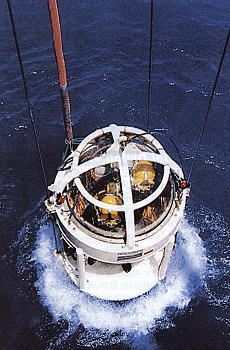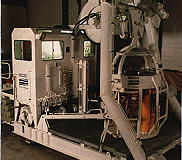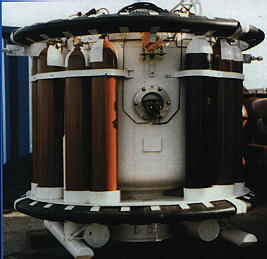|
Today, we still
find modern application of the old diving bell. It is a simple
transport-bell, used to transfer divers from the deck of the diving-vessel
to the area where they have to do their work and back again. In fact it
concerns a closed dome with a few glass view ports, standing on an open
construction, based on a working floor. The divers stand under the dome
during the transfer. The air-pressure inside of the dome is equalized in
accordance to the ambient water-pressure, so that the divers stay with the
upper part of their body in a dry surrounding. Once arrived on the
required depth, they bend down and leave the bell through the openings in
the side. When the work is done, they enter the bell again and are
hoisted back to the surface. Dependant to the time and depth of the dive
the decompression can take place by pulling up the bell to the different
depths and keeping this during the needed decompression-steps on certain
levels (wet decompression-system).
To keep the bell in a
vertical position, it is provided with a ballast-weight. To keep the dome
free of water, the bell has an air-supply from the diving-vessel. For
emergency-cases there are built some cylinders with compressed air mounted
outside of the bell, that can be opened by the divers. In general these
transport-bells are equipped with a telephone communication with the
diving-vessel and an electric illumination system. The bell can be fitted
out with oxygen masks that can be used during the last
decompression-stops.
|


